|
|
Alligator squash or Jacare in Paraguayan Guarani. Bumpy crookneck shape. Popular in Brazil. Weighs up to 6 kg.
|
|
The Butterkin F1 squash is very new to the commercial market, both for growing and eating.
A handy Muscade for Central Europe. Earlier than Muscade de Provence and Banat, uniform, good harvest, and with a very good dark-orange flesh.
Plant: vine;
Fruit: 15 x 10 cm, Flesh: darkorange, shining, very good quality, sweet, solid,
Weight: 1.0 kg - 2.0 kg
Maturity: 100 days.
As its name suggests, it’s a hybrid between a butternut squash and a pumpkin, and it looks the part. The fruits have the smooth, light orange skin of a butternut and the round, ridged shape of a pumpkin. Inside, the flesh is the best of both worlds – deep orange, smooth, and extremely sweet. Butterkin was developed by Hybrid Seeds in New Zealand for its distinctive sweet and buttery flavour and texture. It measures about 6-to-7.5 inches in diameter and weighs between 2-to-4 pounds.
|
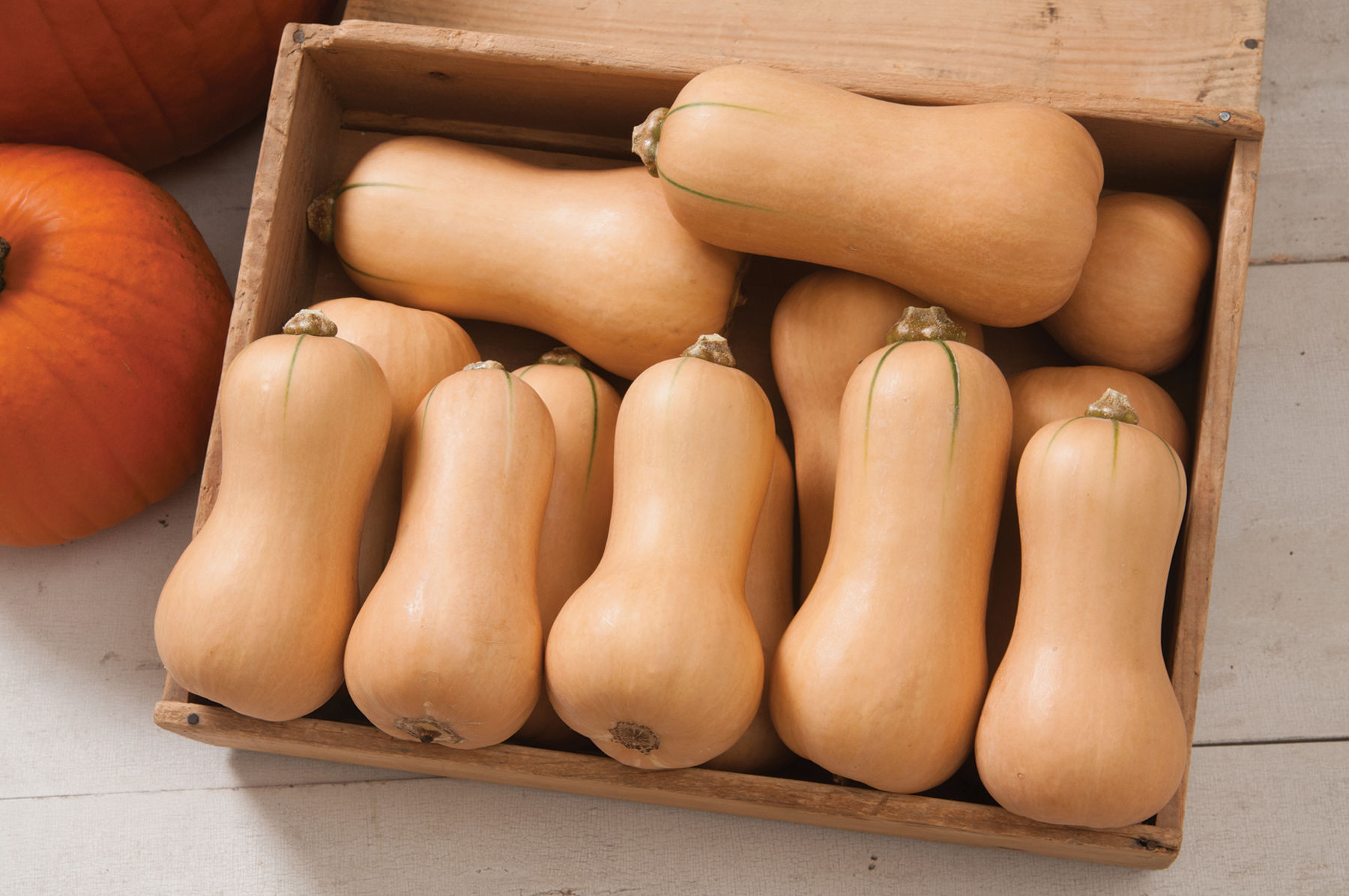
Very suitable for pies and cooking.
Larger fruits with small seed cavities and thick, straight, cylindrical necks. Fruits avg. 9" long, avg. 4-5 lb. Flesh has smooth texture and sweet flavor, particularly after 2 months of storage. Also known as Milk pumpkin in Asia for its milky aroma.
Varieties:
Violina Di Rugosa Butternut
One of the best known and appreciated pumpkin varieties in Northern Italy.
Also known as "violin squash" due to its characteristic shape, it
is also called Gandiotti pumpkin in the Mantuan area, or Rugosa; used for tortelli.
Hercules Butternut
Honeynut
Nutterbutter - This variety was selected for precocity by High Mowing Seedlord in Vermont with the help of Jodi-Lew Smith.
Ponca - This variety of the USA (named in honor of the Ponca Native American people) was developed by Dermot P. Coyne of the University of Nebraska at Lincoln in 1976. It comes from a cross between "New Hamsphire Butternut" and "Butternut" 23 ".
Waltham - The first types of Butternut appeared in New England in the 1930s. They are probably from Canada Crookneck. The variety "Butternut Waltham" was developed in 1968 by Bob Young of Waltham Agricultural Experiment Station in Massachusetts. He crossed the variety "New Hampshire Butternut" with a variety without collar of Turkey. This variety "New Hamsphire Butternut" was developed in 1956 by Yeager and Meader from a cross between "Butternut" and "Taurukubi".
Canada Crookneck - This traditional variety was mentioned for the first time in 1824 in Virginia House-Wife by Mary Randolph. It was introduced commercially in 1834 by the seedman Charles Hovey of Boston. It is also known as "Canadian Winter Crookneck", "Couge Cou Tors of Canada".
Canada Mezoides - Excellent variety of 'Butternut' type. Early and productive. Epidermis and flesh are darker in color than Butternut Waltham. The flesh is finely granular. Ideal for pies.
Orange Butternut Sonca
A Hungarian variety. Its name comes from the color of ripe fruit. In Hungarian it is called Soncatök (ham squash) and is sometimes sold under the name of Sonca.
Weight: 1.3 kg - 2.0 kg.
Maturity: 105 days
Tromboncino
Also known as Tromboncino d'Albenga, or Trompette d'Albenca. An Italian heirloom with a wonderful curvy neck and a nice light brown skin. Very easy to grow and great for baking. Scoring on the neck part is without seeds and, therefore, easy to peel and bake. 85 days. Favored for its especially long neck, making slicing and cooking the squash easy and convenient.
Beja
The BEJA variety comes from Hungary. The name is the abbreviation of its father's name, Professor Bereni Janos. A Butternut- pear-shaped, with seeds only in the lower widened part. The pulp is fine, pale orange, named after the buttery consistency. The normal skin color is ocher, and light. Beja is a bit different butternut. Unripe fruits are dark green, at the time of ripening, the skin is dyed in a deep ocher to orange-brown color.
The intensity of the coloring is reflected in the pulp - it is deep orange, sweet and tasty. It can also be eaten raw. Beja is excellent for soups, spreads, puddings. It is well-storable, Prof. Bereni focused on this property when choosing from the old regional variety Sonca.
Weighs up to 2 - 2,5 Kg.
Butterbush
True bush vines. Grow this butternut squash in a big pot or as tidy, small plants in the garden, chubby 2 to 3 pound, creamy-tan colored fruits. Each bush bears 4-5 butternut-shaped fruits averaging 1 1/2 lb. The bright orange flesh is smooth with sweet butternut flavor. One of these squashes is perfect for a meal for two. Stores well. A hybrid bred in England.
Ultra Butternut
Cobnut
|
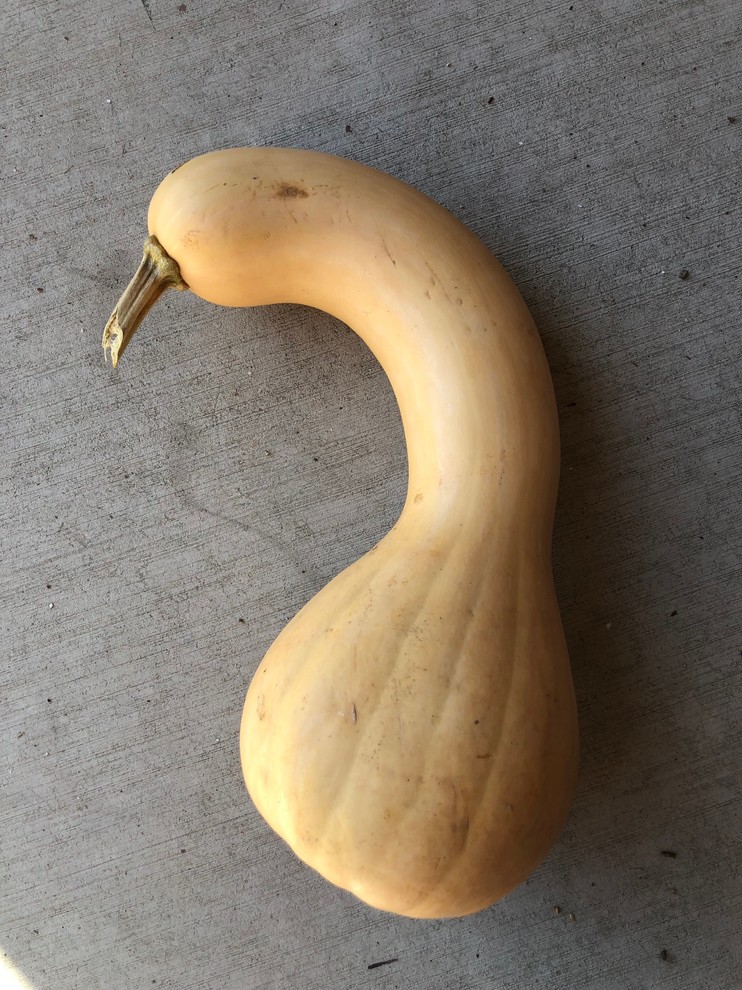
Suitable for cooking and pies.
Old New England variety, preserved at Old Sturbridge Village, Massachusetts, where our foundation seed came from. Reportedly originated among the Iroquois Indians. Introduced 1834 by Boston seedsman Charles H. Hovey, this ancestor of today's Butternut was described in detail in Fearing Burr's book of 1865. Little information is available about its Canadian roots, although I did find a reference to it in Henry David Thoreau's book "A Yankee in Canada" from 1850 describing his attempts to find seed for "the real Canada Crookneck squash" in Quebec. The bottle-shaped fruits reach 2-4 lbs, having a curved neck and fine-grained, sweet flesh. 110 days.
When long distance shipping became the norm for many vegetables, it was found that the necks had a tendency to crack when being shipped. The squash was therefore used as a parent to develop the Butternut, which remedied the shipping problem. However, according to one source, half the flavour was lost. This squash has rather short vines, making it a good garden squash, is pest and disease resistant and will keep for long periods. According to James J.H. Gregory, writing in 1893, the fruits were known to keep up to two years! For all these qualities and due to few commercial sources, SlowFood USA listed it on its Ark of Taste.
This traditional variety was mentioned for the first time in 1824 in Virginia House-Wife by Mary Randolph. It was introduced commercially in 1834 by the seedman Charles Hovey of Boston. It is also known as "Canadian Winter Crookneck", "Couge Cou Tors of Canada".
Seed Reviews:
Grows well in: Wisconsin, California, Maine, South Carolina
Similar varieties: Dutch Crookneck, Tahitian Crookneck a US native squash, Pennsylvania Dutch, Neck Pumpkin
Tahitian squash
|

Very suitable for pies and cooking.
One of the creamiest pumpkins, with excellent flavor, this large variety works well in pies, pudding and soup.
the best for making old fashioned pumpkin pie. These have a creamy texture and nice flavor. One pumpkin will make several pies. They taste somewhat like a butternut squash.
Similar varieties:
Buckskin
Buckskin is of U.S.A. origin and is one of the largest commercial varieties grown for canning in Illinois. The fruit is large, round and flattened, with strong ribbing and a buckskin coloured rind. The medium length vines will produce fruit ranging from 3.5kg to 7kg in around 95 days. Inside, the mid-gold coloured flesh is smooth, moist and sweet with a nice flavour (as expected from a commercial variety). It is enjoyed roasted. Note: This variety is not to be confused with the F1 hybrid variety "Autumn Buckskin" which has a different shape.
Ibiza
This variety originates from Ibiza. The fruits are wonderfully tan-coloured and distinctively ribbed. The very thick orange flesh is moist, medium sweet with good flavour. The seed cavity is quite small. The medium sized vines are prolific producers of fruit ranging from 1.5kg to 2.5kg in around 100 days.
|
|
American strain. Very suitable for pies and cooking.
Nearly round to elongated fruits, 18 inches long by 14 inch diameter
up to 40 pounds
slightly furrowed but smooth buff-colored rind
sweet orange high quality flesh
for canning and pies.
This is the pumpkin of choice for Libby's canned pumpkin.
This is a huge, vigorous vine. Each vine produces 3-4 medium-sized pumpkins, and the plants are ornamental enough to grow around large tropicals. The lush, beautiful foliage fits right in. Pumpkins are sweet, not stringy, and a good keeper. Make sure to let them mature completely for best flavor. The skin will be tan, and the flesh deep, pumpkin orange. This ancient variety was mentioned by the seed company Northrup King in 1958.
Seed reviews:
Grown well in Spain, California, Ohio, Wisconsin. Early maturity in Spain, late in Wisconsin.
Kentucky Field Pumpkin
|

Turbinata variety. Its scientific name is Cucurbita pepo var. turbinata 'Fordhook Acorn'.
Introduced in 1890 by W. Atlee Burpee Seed Co. in the U.S., they were named for the company research farm, Fordhook, in Pennsylvania. Growing to 2 lbs, the golden-coloured fruits are long and deeply-ribbed with firm, dry flesh. It is also known as "Early Fordhook", "Fordhook Marrow", "Fordhook Vine" and "Fordhook Oblong". A bush type selection was introduced around 1906 under the name "Fordhook Bush".
Fordhook Marrow
Vining type.
According to a 1928 Burpee Seed Catalogue, they could be eaten as summer squash or winter squash; Eaten fresh at 56 days or for baking at 85 days.
Varieties:
Paydon
This extremely rare large tan acorn migrated from France to Louisiana to Ohio to Basco, IL, where it was maintained by the Paydon family since the 1860s. Flavor, texture and sweetness remind us of Delicata and Sweet Dumpling. Delicious yellow flesh, though a bit stringy. Teardrop-shaped fruits turn from creamy-tan to bright yellow in storage. Extremely vigorous vines give moderate yields of 3 lb fruits. Requires too long a season for cold northerly areas. 105 days.
|
|
An extremely rare heirloom
with beautiful buff skin and
deep orange flesh – a large
squash that stores well –
similar to a butternut but
larger and sweeter. Great for
soups, baking, and pies
Varieties:
Sucrine de Berry
The pear-shaped fruits are 15-25 cm in length and weigh from 1 to 3 kg. Each plant can produce from 5 to 8 fruits. The dark green epidermis becomes ocher at full maturity. The red-orange flesh is sweet, musky and delicious. The fruits are kept from 3 to 6 months.
This very old variety is from France. It is also called "Sucrette du Berry" or Sugar Berry.
|
|
|
|
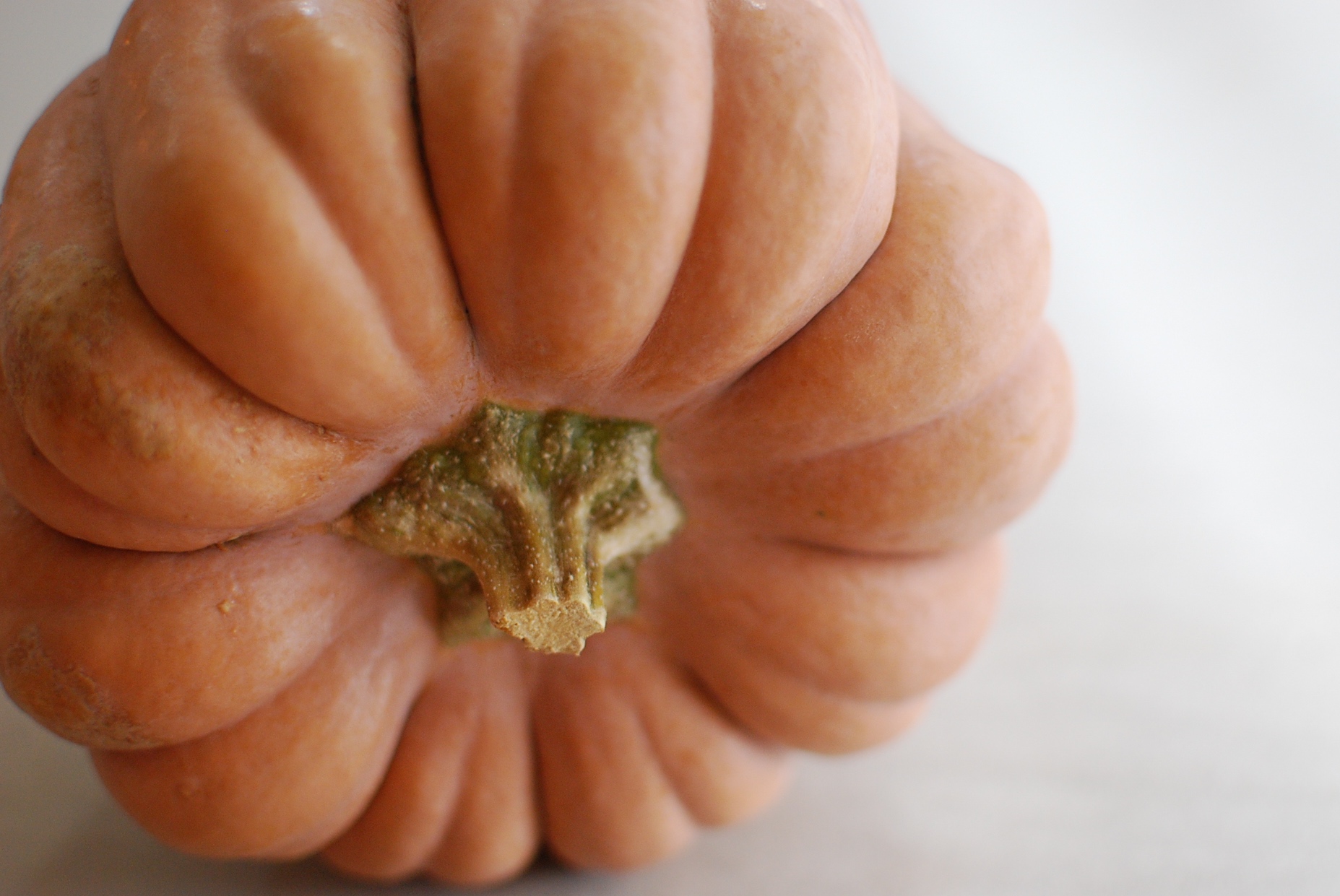
This Japanese heirloom is a good producer of small, tan colored pumpkins that are heavily ribbed. Orange flesh is sweet and dry and has a spicy flavor. Very hard to find. A great variety for specialty markets. First offered in America by the Oriental Seed Company of San Francisco in 1927.
Seed Reviews:
Grows well. Has nice warm, spicy flavour. Nice size for two people to share.
Varieties:
Hikata
This variety is probably native to Japan. This variety produces rounded fruit, flattened, superficially ribbed, weighing 2 to 4 kg. The flesh is dark orange, sweet and aromatic. The fruits are used to make soups, mashed potatoes, jam, grated raw, gratin, donut, stir fry, ratatouille. 110 days.
Latin name: Cucurbita moschata Duch. 'Hikata'
Synonyms: Cucurbita pepo L. var. moschata Duch. 'Hikata', Cucurbita macrocarpa Gasp. 'Hikata'
Common names: Butternut squash Hikata, Hikata musk
Hayato
Hayato is native to Japan and owes its name to a clan based in Kagoshima, in southern Japan, who in ancient times used alien customs and opposed the government. The fruits are in great need of warmth and need plenty of time to fully mature.
|

American. Very suitable for pies and cooking. Very fine texture, no blending required.
This traditional variety is native to the states of New York and New Jersey. Cheese squashes have been mentioned in the USA since 1815, but there is a painting by the painter Lucas Van Valkenborch (1530-1597) at the Museum Kunsthistoriches in Vienna. It was introduced in the collection of the Vavilov Institute in Russia in 1923.
The Long Island Cheese pumpkin is one of the oldest varieties of squash cultivated in America and was one of the first winter squashes to be domesticated for food and animal feed. The Long Island Cheese pumpkin has not only long been known for its culinary attributes but is also recommended as a healthy dietary addition for household pets and when fed raw to chickens is known to help support healthy egg production in the winter months. The Long Island Cheese pumpkin appears in many American seed catalogs, cookbooks and farmers almanacs dating back to the 1800’s. Today, the Long Island Cheese pumpkin seeds are preserved in a regional seed bank on the east coast, and it is grown in the Smithsonian’s Victory Garden at the National Museum of American History.
The vine that produces the Long Island Cheese pumpkin is believed to have originally been grown in Central or South America and made its way to North American gardens via explorers and traders. Officially introduced to the commercial marketplace in an 1807 seed catalog by Bernard McMahon of Philadelphia the pumpkin was a popular variety grown along the Atlantic seaboard throughout the 1800’s. It remained a popular squash up until the 1960’s when new pumpkin varieties started to come onto the market which were better suited for modern growing, harvesting and distribution techniques. The seeds of the Long Island Cheese pumpkin were saved in the 1970s as part of the Long Island Seed Project in efforts to preserve the genetic resources of heirloom seeds in the Long Island region. Long Island Cheese pumpkins thrive in hot and humid climates and are the least cold tolerant of all squashes.
Seed reviews: Grows well in Ohio, South Dakota, Colorado, New Jersey, Pennsylvania
|
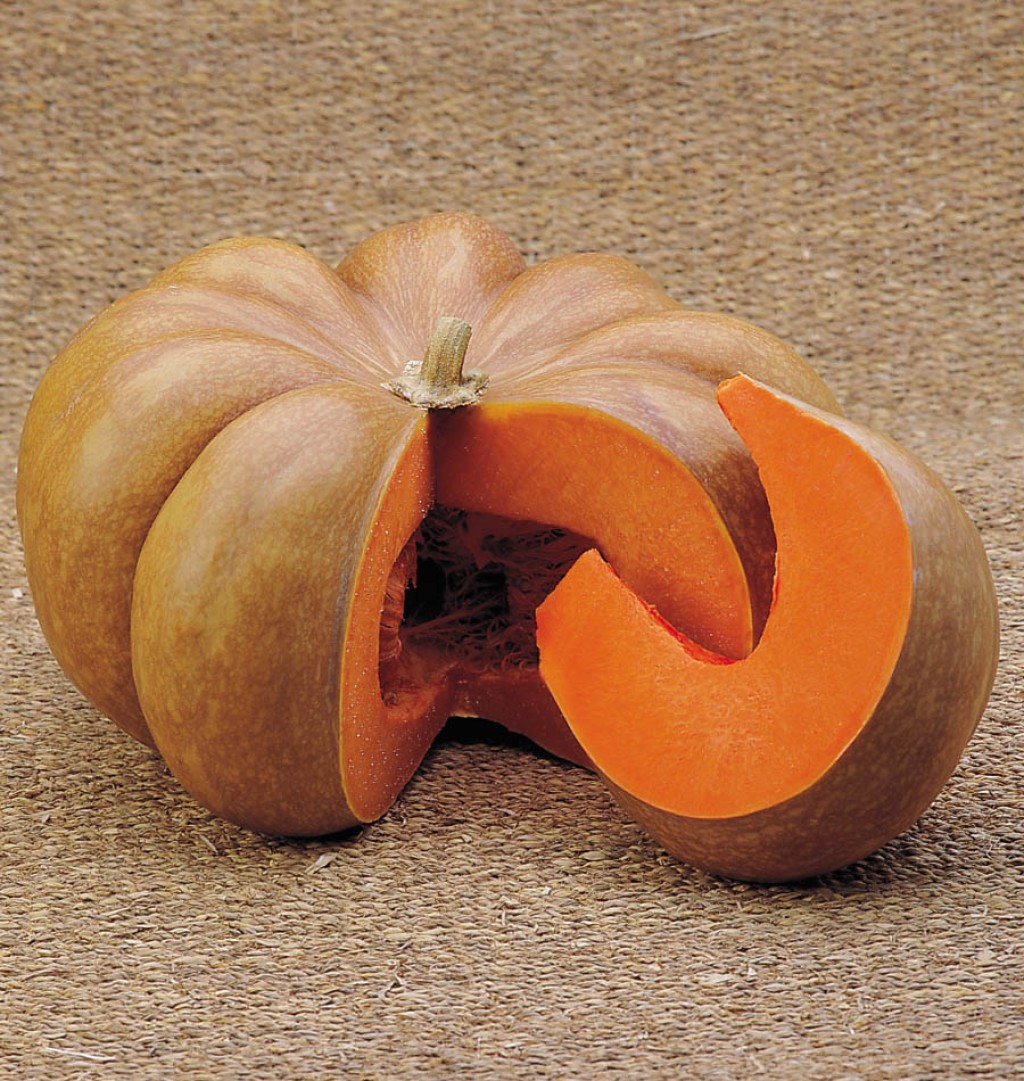
Fairytale pumpkin
This is an old time pumpkin from southern France. It is deeply ribbed and has a very smooth hard surface. It is dark green in color when immature, and as it cures it turns a gorgeous deep mahogany. It is fine grained and well suited for pies.
Firm and fragrant pulp, with a typical nutty taste that characterizes the C. moschata species. It corresponds to the pumpkin Potiron bronze de Montlhéry,
cited by Vilmorin (1890).
They are waxy and rotund and resemble Cinderella’s carriage. The Fairytale pumpkin was first introduced to the American market in 1899 by Vaughn’s Seed Store of Chicago.
Seed Reviews
Wisconsin: great producer
Toronto, Canada: Large plants, 12-ft runners, enormous leaves, seems to shrug off stem borers, leaf beetles and moulds. Twice grew fruit to over 20 lbs. Extremely long keeper, even in room temperatures (we ate our dining room decoration after 5 months). Very fine-grained brilliant-orange flesh is superior to any other squash/pumpkin I've ever eaten. A real gem.
Slow to grow
Also grown in California, New York, Pennsylvania, North Carlina, Texas, Michigan almost all States.
Varieties:
Musquee de Nepal
The fruits are either flattened or elongated. The epidermis is green marbled with brown, and the flesh is yellow-orange.
It is an ancient population originating from Nepal.
Musquee d'Ancenis
Fruit: green with orange spots, round very flattened. Taste : Firm, slightly sweet, slight carrot taste. Fruit size: 25 cm in diameter. Height 13 cm. Weight: 4 kg flesh: yellow-orange, firm. Description / information: Ancenis commune of Loire-Atlantique (France).
Bronze de Montlhéry
Also known as Tanned of Montlhery, from the region in France. Greenish brown, ribbed skin, bright yellow flesh.
Rumbo
Said to have an excellent flavour and very good roasted or for pies. An F1 that produces good yields of 15 lb pumpkin shaped winter squash. Is it a pumpkin that tastes like a winter squash or is it a winter squash that looks like a pumpkin? The flattened ribbed squash looks somewhat like Cinderella pumpkin or an old-fashioned cheese pumpkin, but the flavor is that of a superior quality winter squash. The very thick dark orange-yellow flesh is even sweeter than acorn squash without the stringiness. Quality holds for a long time, allowing plenty of time to display the unique fruits prior to eating them. Yields are higher than most other winter squash. Excellent choice for home gardens and specialty market growers. A winter squash variety. 100 days.
Pearl
Moschata from Russia.
Plant: vine;
Fruits: variable in form, mostly round, flattened, green-brown; Size (HxL): 14 x 25 cm; Flesh: dark orange;
Usage-Recommendation: Frying/Grill, Oven, Steam, Salad/Dip, Deep-Fry
Storage time: ++++
Weight: 3.0 kg - 5.0 kg
Maturity: 120 days
|
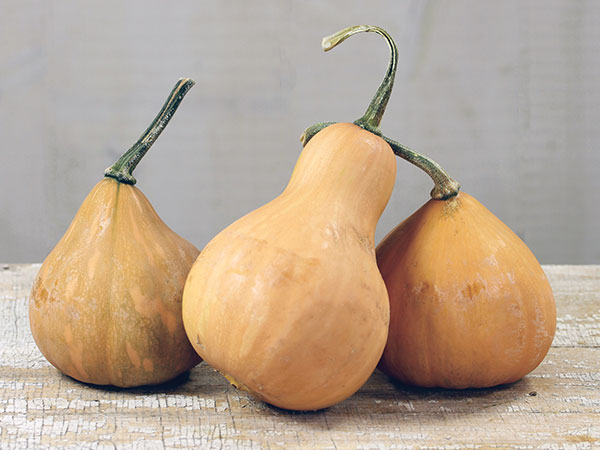
Very suitable for pies and cooking.
The wild squash of the Everglades. The round, lightly ribbed 3-lb squash have tan skin. The sweet flesh is deep orange, dry and of good quality. The productive vines are resistant to insects and disease. Found growing wild in Florida by early Spanish settlers, it can now only be found in remote parts of the Everglades. Plant like rich fertile soil.
Seminole pumpkins are a cultivated variety (cultivar) of Cucurbita moschata; some other notable cultivars of this species include butternut squash and Calabaza. Seminole pumpkins come in a variety of shapes and colors. While generally rounded and dull orange, their appearance can vary—even on the same plant. The inner flesh of Seminole pumpkins is orange and tastes like butternut squash, but sweeter. The flesh is firmer and less fibrous than that of a traditional jack-o-lantern pumpkin (Cucurbita pepo). The mature fruits generally weigh 6 to 12 pounds.
Good growing reviews, large fruits.
Varieties:
Texas Indian
The vigorous plants produce an abundance of flattened fruits, slightly ribbed, of 5-7 kg. The epidermis is orange-ocher.
Related: Rio Mayo Segualca (moschata) or Mayo Segualca:
Also called Magdalena Big Cheese squash.
Variety originally from Los Capomos, an ancient ceremonial village in northern Mexico. The seeds were recovered by the Native Seed association of New Mexico.
Variety that does not have a standard shape but is very variable in appearance.
The epidermis is light green dotted. The taste is sweetened.
Mayo Kama
(moschata)
A butternut shaped fruit with flavorful salmon colored flesh. Productive until frost. From a low desert location in Sonora, Mexico. One of our farmer-partners grew a terrific harvest in Phoenix, AZ.
Yoeme Segualca
Taste : Firm, bland, unsweetened.
Guarijio Segualca
Native to the Sonoran Desert, enjoy Guarijio heritage squash as you would pumpkin or any of your favorite squash recipes.
Xingo Casca
A variety from Brazil, needs plenty of warmth. Fruits: flattened, green, mottled; Size (D): 25 cm; Flesh: dark orange, sweet;
Usage-Recommendation: Frying/Grill, Oven, Steam, Salad/Dip, Deep-Fry
Storage time: ++++ Weight: 2.0 kg - 3.0 kg Maturity: 140 days
Hopi Tan
Ancient variety, originally from Arizona, hence the name of the native Hopi tribe. The shape of the pumpkins is of large flattened butternuts, weighing between 3 and 5 kg. Good conservation.
Carrizo
Carrizo is a Mexican heirloom variety, very popular in the region of Southern Sonora. The fruit is a small butternut or short crookneck shape and size with very smooth buff coloured rind. The small vines produced fruit up to about1.3kg in around 90 days. Inside, the light orange coloured flesh is firm, fairly moist and mild to medium sweet.
Cherokee Tan
Harvest when fruit is changing colour (green to tan) and before frosts. Cut a long stem. Plant is 30' long with roots along the vines.
|
|
Also Known as Thelma Sanders Acorn Squash
Family heirloom from Thelma Sanders in Adair County, MO. Introduced 1988 by SESE.
Acorn-type squash up to 6 in. long. Ripens from cream to light gold. Thick, golden yellow flesh with fine texture and superb flavor. Sweetens in storage. Great vigor in VABF’s 2009 squash trials. An heirloom originating from Missouri.
Seed reviews:
Grows well all over USA.
|
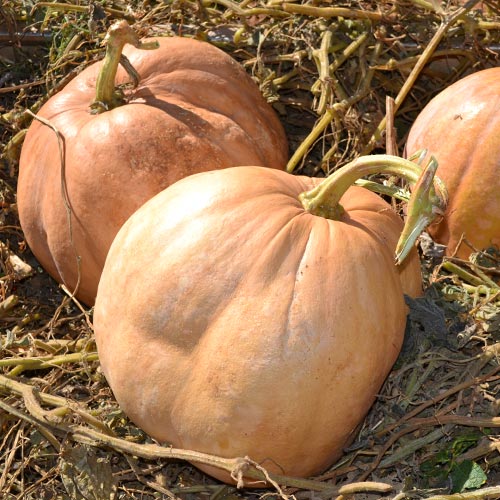
This rare heirloom is a rugged variety that is tolerant of hot, dry weather, rendering it especially well-suited to the South.
The vines are vigorous, with large, dark, metallic green-striped leaves, and it produces an abundance of medium-large, round-to-bell-shaped, tan-skinned fruit and moist orange flesh that resembles that of the sweet potato, hence the name.
The Upper Ground Sweet Potato Winter Squash can weigh up to 20 pounds when ripe. Drought Tolerant. An Appalachian heirloom variety from Kentucky. It was grown by Thomas Jefferson at Monticello, Virginia.
In 1790, Jefferson sent to Samuel Vaughan Jr. seed of a melon species resembling a pumpkin and tasting like the sweet potato, calling it “potato-pumpkin.”
Seed reviews:
Grown successfully throughout the USA, and in Toronto, Ontario, Canada.
Varieties:
Choctaw Sweet Potato Squash
These caught attention in Twin Oaks’ 2013 observation trials because of their ability to resist Downy Mildew. 10-20 pound oblong fruits are sweet and bright orange on the inside (tan outside), but have low dry matter content. They are good as summer squash when picked at about 6-8 inches long. Note that moschata squashes don’t get vine borers. A family heirloom from Randy Baker in Mississippi, whose family has grown it for a long time. I got seeds from Charlotte Hagood of Sand Mountain Seed Bank. 115 days (75 days for summer squash).
Vitamin Pumpkin
A variety from Russia. Fruits: Shape is typically upright, though variable, brown. Size (DxH): 30 x 16 cm; Flesh: cream to yellow, thick, dry, sweet, with a delicate and discreet hazelnut aroma; less sweet as Butternut but a richer taste.
Usage-Recommendation: Frying/Grill, Oven, Steam, Salad/Dip, Deep-Fry Storage time: ++++ Weight: 3.0 kg - 5.0 kg Maturity: 100 days
Tennessee Old Fashioned Vining squash
Pumpkin that forms large oval fruits, which can weigh from 6 to 15 kg. Epidermis ocher colored, orange pulp, with typical flavor of the C. moschata. Introduced commercially in 1988.
Miller's Cove
Miller's Cove is an heirloom pumpkin variety from Tennessee U.S.A. It is a medium to large variety with fruit ranging from 4kg to 12 kg. The fruit is round and slightly flattened with many ribs and smooth yellow-tan rind. The vines are quite substantial and will produce fruit in around 105 days. Inside, the thick orange flesh is firm, moist, sweet and very tasty. It contains very few seeds for it's size.
|
|
This amazing flat squash from China is causing quite a stir. The fruits possess amazing eye appeal—burnt-orange to chestnut-brown skin, covered in a waxy bloom. Each 3- to 8-pound fruit is incredibly deeply ribbed, and most unusual of all is the way the top of each fruit dramatically recurves toward the stem, sometimes completely enfolding it. The red-orange flesh is very sweet and of very high quality. Use in soups, purées, cakes, and sweet dishes of all types. They are great keepers, too, easily lasting 3-4 months. One of the most intriguing squashes we offer, and a new favorite here. We found seeds for this most beautiful variety from a Chinese seed seller, who had a small stand setup in Fang, Thailand. The most interesting squash we have found in years. 130 days.
|
|
From Hawaii, a new breed bred from landrace squash by Squash and Awe. Small size (3-4lb max), smooth, easy to peel, versatility in flavor profile (can be used in a wide variety of dishes,) pest and disease resistance (especially powdery mildew and pickleworm,) and best of all it is a contender to give the imported bland little kabochas a run for their money.
|
|
|
 MBZ
MBZ
